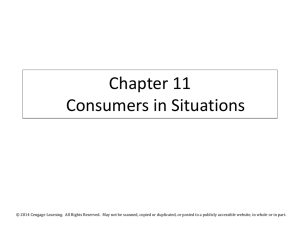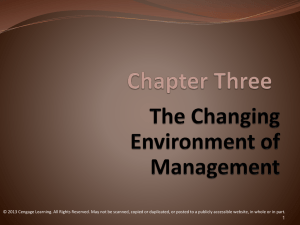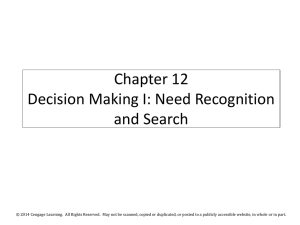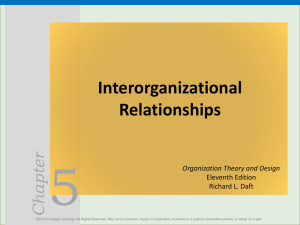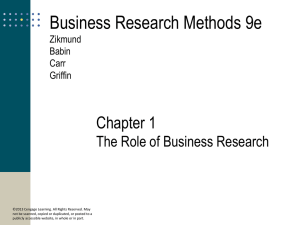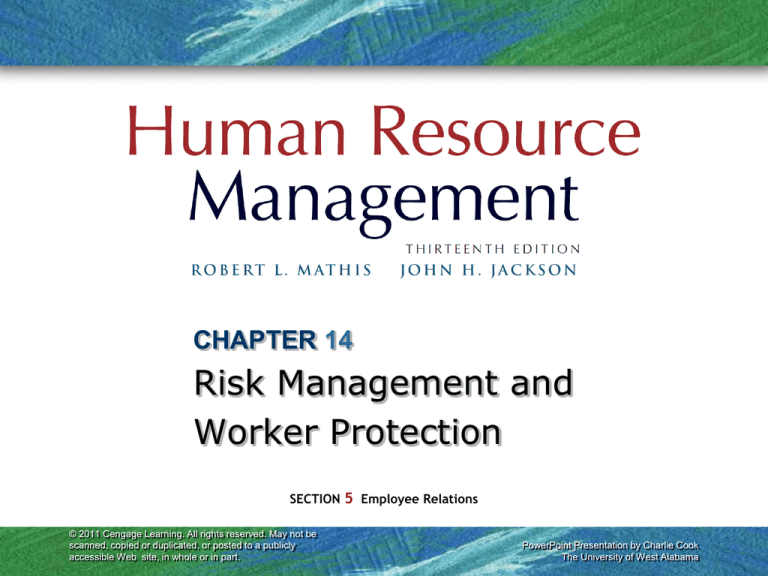
CHAPTER 14
Risk Management and
Worker Protection
SECTION 5 Employee Relations
© 2011 Cengage Learning. All rights reserved. May not be
scanned, copied or duplicated, or posted to a publicly
accessible Web site, in whole or in part.
PowerPoint Presentation by Charlie Cook
The University of West Alabama
Chapter Objectives
After you have read this chapter, you should be able to:
•
Identify the components of risk management.
•
Discuss three legal areas affecting safety and health.
•
Identify the basic provisions of the Occupational Safety and Health
Act of 1970 and recordkeeping and inspection requirements.
•
Discuss the activities that constitute effective safety management.
•
List three workplace health issues and how employers are
responding to them.
•
Explain workplace violence as a security issue and describe some
components of an effective security program.
•
Describe the nature and importance of disaster preparation and
recovery planning for HR.
© 2011 Cengage Learning. All rights reserved. May not be scanned,
copied or duplicated, or posted to a publicly accessible Web site, in
whole or in part.
14–2
Effective Risk Management
• Risk Management
Involves responsibilities to consider physical, human,
and financial factors to protect organizational and
individual interests.
Focus of Risk Management
Health
Safety
Security
(Individual)
(Physical)
(Organizational)
© 2011 Cengage Learning. All rights reserved. May not be scanned,
copied or duplicated, or posted to a publicly accessible Web site, in
whole or in part.
14–3
Risk Management
Preventing
accidents and health
problems at work
Preparing for
natural disasters
Planning for
terrorism attack
Risk
Management
Concerns
Anticipating global
disease outbreaks
Protecting against
workplace violence
Ensuring HR data
are secure
© 2011 Cengage Learning. All rights reserved. May not be scanned,
copied or duplicated, or posted to a publicly accessible Web site, in
whole or in part.
14–4
FIGURE 14–1
Hidden Costs of Accidents
© 2011 Cengage Learning. All rights reserved. May not be scanned,
copied or duplicated, or posted to a publicly accessible Web site, in
whole or in part.
14–5
Risk Management
Size and location
of organizations
Involvement and
capabilities of HR
professionals
Strategic priorities
of each
organization
Factors
Affecting
Risk
Management
Industry
characteristics
and demands
Geographic and
global location
factors
Governmentmandated programs
and requirements
© 2011 Cengage Learning. All rights reserved. May not be scanned,
copied or duplicated, or posted to a publicly accessible Web site, in
whole or in part.
14–6
Global Health, Safety, and Security
Health and Safety in
High-Risk International
Environments
International
Emergency Health
Services
International Security
and Terrorism
© 2011 Cengage Learning. All rights reserved. May not be scanned,
copied or duplicated, or posted to a publicly accessible Web site, in
whole or in part.
Kidnapping and Other
Acts of Violence
14–7
Legal Requirements for Safety and Health
Major Legal Areas
Workers’
Compensation
Americans with
Disabilities Act
and Safety Issues
© 2011 Cengage Learning. All rights reserved. May not be scanned,
copied or duplicated, or posted to a publicly accessible Web site, in
whole or in part.
Child Labor
Laws
14–8
FIGURE 14–2
Sample of Worker’s Comp Covered Injuries
Source: Adapted from Nicole Nestoriak and Brooks Pierce, “Comparing Workers Compensation
Claims with Establishments Responses to the 5011,” Monthly Labor Review, May 2009, 63.
© 2011 Cengage Learning. All rights reserved. May not be scanned,
copied or duplicated, or posted to a publicly accessible Web site, in
whole or in part.
14–9
FIGURE 14–3
Selected Child Labor Hazardous Occupations
(minimum age: 18 years)
© 2011 Cengage Learning. All rights reserved. May not be scanned,
copied or duplicated, or posted to a publicly accessible Web site, in
whole or in part.
14–10
Occupational Safety and Health Act
• Occupational Safety and Health Act of 1970
Passed to assure safe and healthful working
conditions.
Occupational Safety and Health Administration
(OSHA) administers provisions of the Act.
OSHA Enforcement Standards regulate equipment
and working environments:
The
“general duty” of employers to provide safe
and healthy working conditions.
Notification
and posters are required of employers
to inform employees of OSHA’s safety and health
standards.
© 2011 Cengage Learning. All rights reserved. May not be scanned,
copied or duplicated, or posted to a publicly accessible Web site, in
whole or in part.
14–11
FIGURE 14–4
Distribution of Nonfatal Occupational Injuries versus
Illnesses by Private Industry Sector, 2008
© 2011 Cengage Learning. All rights reserved. May not be scanned,
copied or duplicated, or posted to a publicly accessible Web site, in
whole or in part.
14–12
Occupational Safety and Health Act (cont’d)
Hazard Communication
Bloodborne Pathogens
Personal Protective
Equipment (PPE)
OSHA
Enforcement
Standards
Cumulative Stress Disorders
Work Assignments
© 2011 Cengage Learning. All rights reserved. May not be scanned,
copied or duplicated, or posted to a publicly accessible Web site, in
whole or in part.
14–13
Occupational Safety and Health Act (cont’d)
Work Assignments and OSHA:
Employer Obligations and Employee Rights
Reproductive Health
Refusing Unsafe Work
• Maintain safe workplace by
seeking safest working methods.
• Comply with state and federal
safety laws.
• Inform employees of known risks.
• Document employee acceptance
of any risks.
• The employee’s fear is objectively
reasonable.
• The employee has tried to have
the dangerous condition
corrected.
• Using normal procedures to solve
the problem has not worked.
© 2011 Cengage Learning. All rights reserved. May not be scanned,
copied or duplicated, or posted to a publicly accessible Web site, in
whole or in part.
14–14
OSHA Recordkeeping Requirements
Types of
Injuries
Injury- or
illness-related
death
Lost-time
or disability
injuries
© 2011 Cengage Learning. All rights reserved. May not be scanned,
copied or duplicated, or posted to a publicly accessible Web site, in
whole or in part.
Medical care
injuries
Minor
injuries
14–15
FIGURE 14–5
Guide to Recordability
of Cases under the
Occupational Safety
and Health Act
© 2011 Cengage Learning. All rights reserved. May not be scanned,
copied or duplicated, or posted to a publicly accessible Web site, in
whole or in part.
14–16
OSHA Inspections
• On-the-Spot Inspections
Compliance officers
Marshall v. Barlow’s, Inc.
• Dealing with an Inspection
• Citations and Violations
Imminent danger
Serious
Other than serious
Check credentials
De minimis
Opening conference
Willful and repeated
Safety record check
On-the-spot inspection
© 2011 Cengage Learning. All rights reserved. May not be scanned,
copied or duplicated, or posted to a publicly accessible Web site, in
whole or in part.
14–17
FIGURE 14–6
Typical Division of HR Responsibilities:
Health, Safety, and Security
© 2011 Cengage Learning. All rights reserved. May not be scanned,
copied or duplicated, or posted to a publicly accessible Web site, in
whole or in part.
14–18
Safety Management
Organizational
Commitment and
a Safety Culture
Safety Policies,
Discipline, and
Recordkeeping
Managing
Safety
Effectively
Safety Planning
through
Safety Committees
© 2011 Cengage Learning. All rights reserved. May not be scanned,
copied or duplicated, or posted to a publicly accessible Web site, in
whole or in part.
Safety Training
and
Communication
14–19
Safety Management
Organizational commitment
Policies, discipline, and
recordkeeping
Training and communication
Effective
Safety
Management
Participation
(safety committees)
Inspection, investigation,
and evaluation
© 2011 Cengage Learning. All rights reserved. May not be scanned,
copied or duplicated, or posted to a publicly accessible Web site, in
whole or in part.
14–20
FIGURE 14–7
Approaches to Effective Safety Management
© 2011 Cengage Learning. All rights reserved. May not be scanned,
copied or duplicated, or posted to a publicly accessible Web site, in
whole or in part.
14–21
FIGURE 14–8
Phases of Accident Investigation
© 2011 Cengage Learning. All rights reserved. May not be scanned,
copied or duplicated, or posted to a publicly accessible Web site, in
whole or in part.
14–22
Inspection, Investigation, and Evaluation
Measuring
Safety
Efforts
Accident
and Injury
Statistics
Worker
Compensation
Costs
© 2011 Cengage Learning. All rights reserved. May not be scanned,
copied or duplicated, or posted to a publicly accessible Web site, in
whole or in part.
Illness/Injuries
by Areas,
Shifts, and
Jobs
Incident Rate
and
Benchmark
Comparisons
14–23
Substance Abuse
• Substance Abuse
Use of illicit substances or misuse of controlled
substances, alcohol, or other drugs.
• Types of Drug Tests
Urinalysis
Radioimmunoassay of hair
Surface swiping
Fitness-for-duty tests (impairment)
• Handling Substance Abuse Cases
ADA does not protect current users of illegal drugs.
Addiction to legal drugs is considered a disability.
Use of the firm-choice option
© 2011 Cengage Learning. All rights reserved. May not be scanned,
copied or duplicated, or posted to a publicly accessible Web site, in
whole or in part.
14–24
FIGURE 14–9
Common Signs of Substance Abuse
© 2011 Cengage Learning. All rights reserved. May not be scanned,
copied or duplicated, or posted to a publicly accessible Web site, in
whole or in part.
14–25
Other Employee Health Concerns
Employee Health
Emotional/Mental
Health
Health and
Older Employees
© 2011 Cengage Learning. All rights reserved. May not be scanned,
copied or duplicated, or posted to a publicly accessible Web site, in
whole or in part.
Smoking
at Work
14–26
Health Promotion
• Health Promotion
A supportive approach of facilitating and encouraging
healthy actions and lifestyles among employees.
• Wellness Programs
Programs designed to maintain or improve employee
health before problems arise.
• Employee Assistance Program (EAP)
A program that provides counseling and other help to
employees having emotional, physical, or other
personal problems.
© 2011 Cengage Learning. All rights reserved. May not be scanned,
copied or duplicated, or posted to a publicly accessible Web site, in
whole or in part.
14–27
FIGURE 14–10
Health Promotion Levels
© 2011 Cengage Learning. All rights reserved. May not be scanned,
copied or duplicated, or posted to a publicly accessible Web site, in
whole or in part.
14–28
Security Concerns at Work
Security
Concerns
Workplace
Violence
Security
Management
© 2011 Cengage Learning. All rights reserved. May not be scanned,
copied or duplicated, or posted to a publicly accessible Web site, in
whole or in part.
Employee
Screening and
Selection
Security
Personnel
14–29
Workplace Violence
Workplace Violence Issues
Workplace
Violence
Warning Signs
Training in
Detection and
Prevention
© 2011 Cengage Learning. All rights reserved. May not be scanned,
copied or duplicated, or posted to a publicly accessible Web site, in
whole or in part.
Post-Violence
Management
Responses
14–30
FIGURE 14–11
Profile of a Potentially Violent Employee
© 2011 Cengage Learning. All rights reserved. May not be scanned,
copied or duplicated, or posted to a publicly accessible Web site, in
whole or in part.
14–31
Security Management
Security Audit
Security
Management
Programs
Controlled Access
Computer Security
© 2011 Cengage Learning. All rights reserved. May not be scanned,
copied or duplicated, or posted to a publicly accessible Web site, in
whole or in part.
14–32
FIGURE 14–12
Disaster Planning Components
© 2011 Cengage Learning. All rights reserved. May not be scanned,
copied or duplicated, or posted to a publicly accessible Web site, in
whole or in part.
14–33
Disaster Preparation And Recovery Planning
First Aid/CPR
Hazardous Materials
Containment
Disaster Escape Means
Disaster
Training
Topics
Employee Contact Methods
Organizational Restoration
Efforts
© 2011 Cengage Learning. All rights reserved. May not be scanned,
copied or duplicated, or posted to a publicly accessible Web site, in
whole or in part.
14–34
Progress Check Questions
An organizational disaster recover plan typically
refers to:
A.
B.
C.
D.
Internal and external emergency communications in
the event of a disaster
Procedures to recover business operations in the
event of a disaster
Plans for training, conducting drills, and testing
equipment
Securing adequate insurance to support recovery
efforts if needed
Answer: B
© 2011 Cengage Learning. All rights reserved. May not be scanned,
copied or duplicated, or posted to a publicly accessible Web site, in
whole or in part.
14–35
Progress Check Questions
The Control of Hazardous Energy standard
requires an employer to:
A. Maintain an inventory of hazardous chemicals in the
workplace
B. Attach signs or labels to all pieces of equipment
C. Implement lockout/tagout procedures.
D. Provide employee training programs on hazardous
materials
Answer: C
© 2011 Cengage Learning. All rights reserved. May not be scanned,
copied or duplicated, or posted to a publicly accessible Web site, in
whole or in part.
14–36
Progress Check Questions
A hazardous condition in the workplace that is
causing or is likely to cause death or serious
physical harm is an example of a:
A.
B.
C.
D.
Serious violation
Willful violation
Repeat violation
De minimis violations
Answer: A
© 2011 Cengage Learning. All rights reserved. May not be scanned,
copied or duplicated, or posted to a publicly accessible Web site, in
whole or in part.
14–37
Progress Check Questions
A company has a contest in which the department
that has the lowest number of accidents will
receive an award. Which method of sensitizing
employees to the importance of occupational
safety is used in this example?
A.
B.
C.
D.
Goal-oriented training
Safety inspections
Incentive programs
Suggestion programs
Answer: C
© 2011 Cengage Learning. All rights reserved. May not be scanned,
copied or duplicated, or posted to a publicly accessible Web site, in
whole or in part.
14–38
Progress Check Questions
The economic rational for most security programs
is based on which of the following cost
considerations?
A.
B.
C.
D.
Risk of containment requirements
Lost investment income incurred in a loss
Insurance or other indemnity available
Protection costs versus cost of losses incurred without
the protection
Answer: D
© 2011 Cengage Learning. All rights reserved. May not be scanned,
copied or duplicated, or posted to a publicly accessible Web site, in
whole or in part.
14–39


